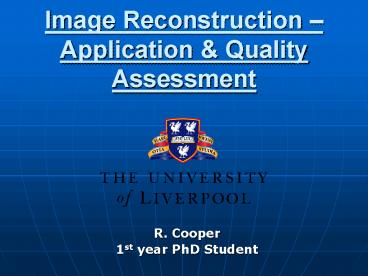Image Reconstruction Application PowerPoint PPT Presentation
1 / 21
Title: Image Reconstruction Application
1
Image Reconstruction Application Quality
Assessment
- R. Cooper
- 1st year PhD Student
2
Overview
- BGO PET development system at Liverpool
- Initial Results (Application of Reconstruction)
- Image Quality Analysis
- Observations
- Further Work
3
The BGO System
- Two banks of 8 BGO tubes
- -ve 900V
- 22Na point sources
- Turntable 5o increments
- Performance
- DE 30 (170keV _at_ 511keV)
- Dt 25ns FWHM
- Singles 750cps _at_ 5cm
- Coincidence 13 cps _at_ 5cm
- two tubes
4
Data Acquisition
- Sources rotated 5o increments
- Data collection for 2 hours per angle
- Singles Mode
- Mg 2 filter in sort
- Coincidence between directly opposite tubes
- LORs defined
5
First Images - FBP
Ramp Filtered Image (Linear Interpolation)
- Very Poor Image
- Limited number of LORs
- - 35 angles x 8 projections 280 LORs
- Insufficient Projections
6
First Images ML-EM
Greyscaled image 16 iterations
- Good Image
- - No artefacts
- - Strong source resolved
- - Small amount of blurring
- - good spatial resolution
- System matrix copes with limited data
- Weak source not present in scaled image
7
Image Matrix
- Output image matrix prior to greyscaling
- Manipulate data (v, 3v, 4v,..)
- Surface Plot
- - clearly identify sources
- Image
- - Greyscale or Colourmap
8
Surface Plots
data
v(data)
3v(data)
4v(data)
9
Modified Images
4v(data) Scaled Images
Greyscale
Colormap
10
Modified Images
- Background matrix defined
- Mean and s calculated
- Background removed pixel by pixel
- Only sources remain in image
11
Image Quality
- Why assess image quality?
- Compare reconstruction algorithms
- Compare imaging systems
- Quantification of perceived quality
12
Image Quality
- What do we mean by image quality?
- How good is an image?
- How well does the system reproduce object
characteristics? - Clinically Does the image allow accurate
diagnosis? - No well structured answer
13
- What are the factors affecting it?
14
- How do we quantify these factors?
- Noise Peak Signal to Noise Ratio (PSNR)
- Blurring Point Spread Function (PSF)
- - Line Spread Function (LSF)
- Spatial Resolution Modulation Transfer
Function (MTF)
15
Blurring - PSF
- Blurring largely due to reconstruction from a
finite number of LORs (FBP) - PSF - output of imaging system for an input point
source
INPUT
OUTPUT
16
Ideal Point Source
Reconstructed Image
FWHM1
FWHM2
Delta Function
Lorentzian
PSF value FWHM1 FWHM2
17
Quality Assessment BGO Data
- Calculated PSNR PSF values
18
Quality Assessment - BGO
19
Observations
- FBP provides poor spatial resolution and noise
suppression for a limited data set - Image quality clearly degraded by matrix
manipulation - Background reduction provides some compensation
20
Further Work
- Investigate effect of gate width
- - Statistics v True coincidence
- How important is system energy resolution to
image quality? - - scatter rejection
- - iterative reconstruction
- Define LORs between more detector pairs
- larger data set
- - reduce blur ?
- Image Quality Single figure of merit
21
R.J. Cooper, A.J. Boston, H.C. Boston, A.N.
Grint, A. Mather, P.J. Nolan

